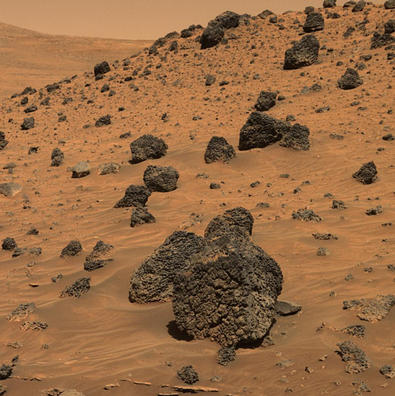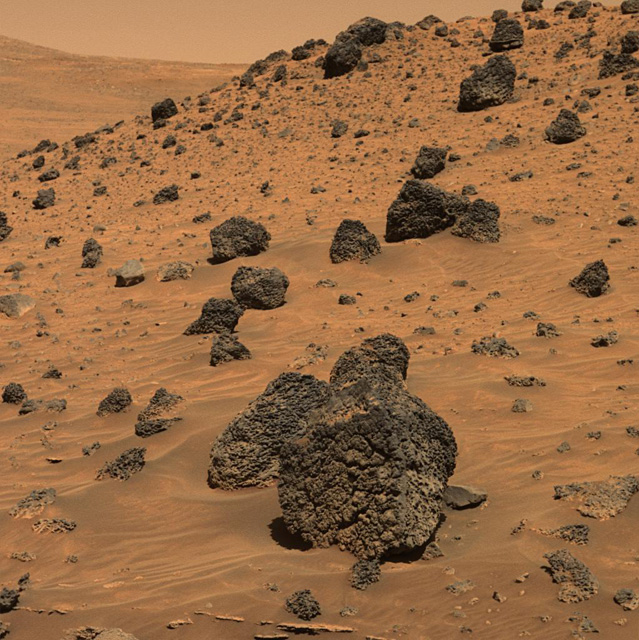Gusev Lava Rocks

| Credit | NASA/JPL-Caltech/Cornell |
|---|---|
| Language |
|
Spirit drove through the basin south of "Husband Hill," mainly over sand and dune deposits. This week, though, Spirit has been maneuvering along the edge of an arc-shaped feature called "Lorre Ridge" and has encountered some spectacular examples of basaltic rocks with striking textures. This panoramic camera (Pancam) image shows a group of boulders informally named "FuYi." These basaltic rocks were formed by volcanic processes and may be a primary constituent of Lorre Ridge and other interesting landforms in the basin.
Spirit first encountered basalts at its landing site two years ago, on a vast plain covered with solidified lava that appeared to have flowed across Gusev Crater. Later, basaltic rocks became rare as Spirit climbed Husband Hill. The basaltic rocks that Spirit is now seeing are interesting because they exhibit many small holes or vesicles, similar to some kinds of volcanic rocks on Earth. Vesicular rocks form when gas bubbles are trapped in lava flows and the rock solidifies around the bubbles. When the gas escapes, it leaves holes in the rock. The quantity of gas bubbles in rocks on Husband Hill varies considerably; some rocks have none and some, such as several here at FuYi, are downright frothy.
The change in textures and the location of the basalts may be signs that Spirit is driving along the edge of a lava flow. This lava may be the same as the basalt blanketing the plains of Spirit's landing site, or it may be different. The large size and frothy nature of the boulders around Lorre Ridge might indicate that eruptions once took place at the edge of the lava flow, where the lava interacted with the rocks of the basin floor. Scientists hope to learn more as Spirit continues to investigate these rocks.
As Earth approaches the Chinese New Year (The Year of the Dog), the Athena science team decided to use nicknames representing Chinese culture and geography to identify rocks and features investigated by Spirit during the Chinese New Year celebration period. In ancient Chinese myth, FuYi was the first great emperor and lived in the east. He explained the theory of "Yin" and "Yang" to his people, invented the net to catch fish, was the first to use fire to cook food, and invented a musical instrument known as the "Se" to accompany his peoples' songs and dances. Other rocks and features are being informally named for Chinese gods, warriors, inventors, and scientists, as well as rivers, lakes, and mountains.
Spirit took this image on the rover's Martian day, or sol, 731 (Jan. 23, 2006). This is an approximate true color rendering combining images taken with the Pancam's 750-nanometer, 530-nanometer and 430-nanometer filters.

